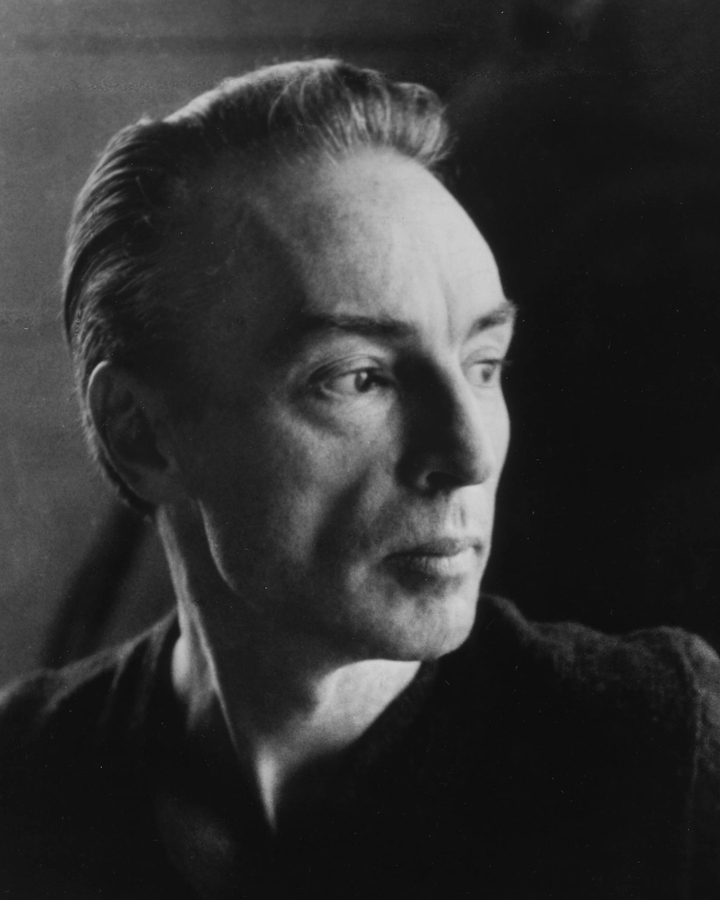George Balanchine

George Balanchine, born Georgi Balantschiwadse in 1904 in St. Petersburg, was one of the most influential pioneers of neoclassical ballet. His path through life, which led him from St. Petersburg to various locations in Western Europe and finally to New York, reads like a journey through the history of dance over the last 100 years: rooted in the ballet world of tsarist Russia and strongly influenced by the aesthetic of Petipa, he joined the Ballets Russes and thus the avant-garde movement in Paris and changed his name to George Balanchine. In 1928 he created »Apollo«, his first masterpiece for Diaghilev’s dance troupe, and thus laid the foundation for his own aesthetic.
In 1933, Balanchine was invited to the United States by Lincoln Kirstein, a prominent industrialist and patron of the arts, which gave him the opportunity to focus on developing his style with dancers specially trained for that purpose. Kirstein persuaded him to become director of a new ballet school, with a view to forming his own company. The School of American Ballet opened in 1934 with an educational concept which had been specially formulated by Balanchine. From the training of dancers, which always formed the basis of his understanding of dance, Balanchine’s path led him to choreography – and what was originally intended as a kind of exercise became his first American masterpiece, »Serenade«.
Further works were to follow at the Metropolitan Opera, for Hollywood and on Broadway, and more and more new ballets were created for his company, which from 1948 onwards became known as the New York City Ballet and which was soon to become one of the world’s leading dance ensembles. In addition to many new creations, including »Concerto Barocco« (1941), »The Four Temperaments« (1946) and »Orphée« (1948), Balanchine built an extensive repertoire based on his existing works. He was able to focus on honing his aesthetic, which had one goal in particular: with the utmost clarity, to make dancing of central importance as a way of making music with the body. The incarnation of this style, and one of the most important examples of New York modernism in the 1950s, was the ballet »Agon«. Further important works were created in the following two decades with »Liebeslieder Walzer« (1960), »Jewels« (1967), »Symphony in Three Movements« (1972), »Stravinsky Violin Concerto« (1972), »Chaconne« (1976), »Davidsbündlertänze« (1980) and »Mozartiana« (1981).
When George Balanchine died in New York on 3 May 1983, he left behind a life’s work comprising 425 ballets, many of which still form part of the repertoires of the world’s great dance companies today.
Performances with George Balanchine
Abo 5
Ticket information
Saison 2024/2025
Einen Wochentag und Lieblingsplätze wählen und fünf Vorstellungen in einer Saison genießen.
In diesem Abo sind folgende Vorstellungen enthalten:
18. Oktober 2024: COSÌ FAN TUTTE
17. Jänner 2025: TURANDOT
21. März 2025: L’ELISIR D’AMORE
11. April 2025: BALLETT: PATHÉTIQUE
23. Mai 2025: NORMA
Abo 9
Ticket information
Saison 2024/2025
Einen Wochentag und Lieblingsplätze wählen und fünf Vorstellungen in einer Saison genießen.
In diesem Abo sind folgende Vorstellungen enthalten:
04. Dezember 2024: IL RITORNO D’ULISSE IN PATRIA
19. März 2025: L’ELISIR D’AMORE
23. April 2025: PARSIFAL
21. Mai 2025: IL TROVATORE
18. Juni 2025: BALLETT: MAHLER, LIVE
Abo 18
Ticket information
Saison 2024/2025
Einen Wochentag und Lieblingsplätze wählen und fünf Vorstellungen in einer Saison genießen.
In diesem Abo sind folgende Vorstellungen enthalten:
17. Oktober 2024: MACBETH
14. November 2024: MANON
12. Dezember 2024: PALESTRINA
27. März 2025: IOLANTA
26. Juni 2025: BALLETT: DORNRÖSCHEN
Abo 22
Ticket information
Saison 2024/2025
Einen Wochentag und Lieblingsplätze wählen und fünf Vorstellungen in einer Saison genießen.
In diesem Abo sind folgende Vorstellungen enthalten:
15. September 2024: LA TRAVIATA
03. November 2024: BILLY BUDD
15. Dezember 2024: PALESTRINA
09. Februar 2025: TOSCA
02. März 2025: BALLETT: DIE KAMELIENDAME
Abo 16
Ticket information
Saison 2024/2025
Einen Wochentag und Lieblingsplätze wählen und fünf Vorstellungen in einer Saison genießen.
In diesem Abo sind folgende Vorstellungen enthalten:
14. Oktober 2024: BALLETT: SCHWANENSEE
25. November 2024: IL RITORNO D’ULISSE IN PATRIA
07. April 2025: SALOME
12. Mai 2025: TOSCA
16. Juni 2025: IL BARBIERE DI SIVIGLIA
Ballettzyklus »Familie«
Ticket information
Vom Jungen, der nicht erwachsen werden möchte, über ein humorvolles Tanzspektakel bis hin zur »perfekten Einführung in die Ballettkunst«: Für alle Menschen ab 10 Jahren lädt der Familienzyklus zum Träumen, Lachen und Verzaubern ein.
Abo 21
Ticket information
Saison 2024/2025
Einen Wochentag und Lieblingsplätze wählen und fünf Vorstellungen in einer Saison genießen.
In diesem Abo sind folgende Vorstellungen enthalten:
08. September 2024: ROMÉO ET JULIETTE
10. November 2024: BILLY BUDD
01. Dezember 2024: BALLETT: THE WINTER’S TALE
30. März 2025: COSÌ FAN TUTTE
25. Mai 2025: TANNHÄUSER